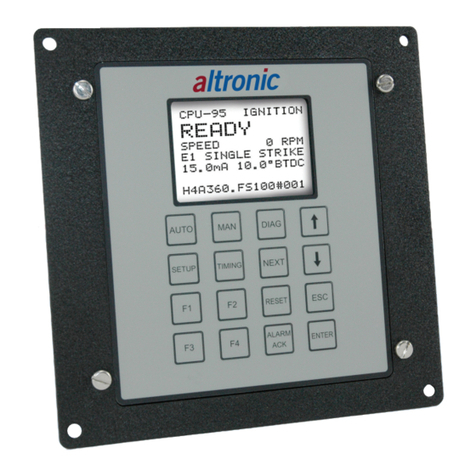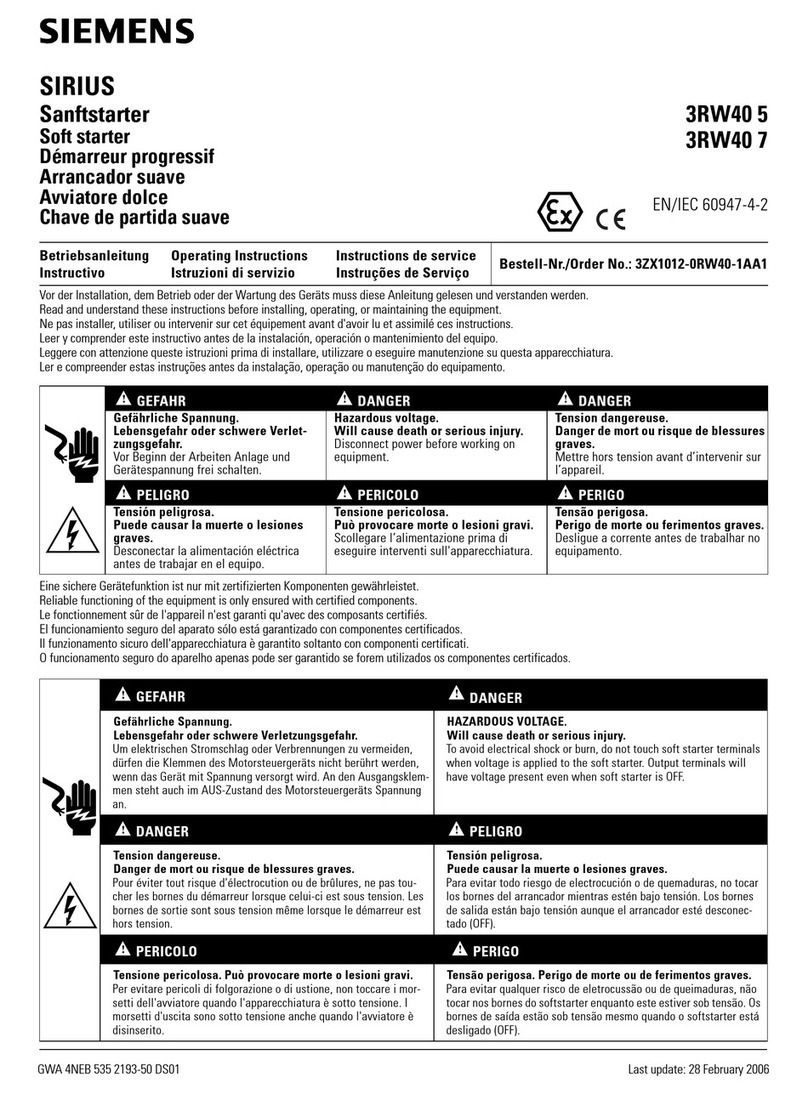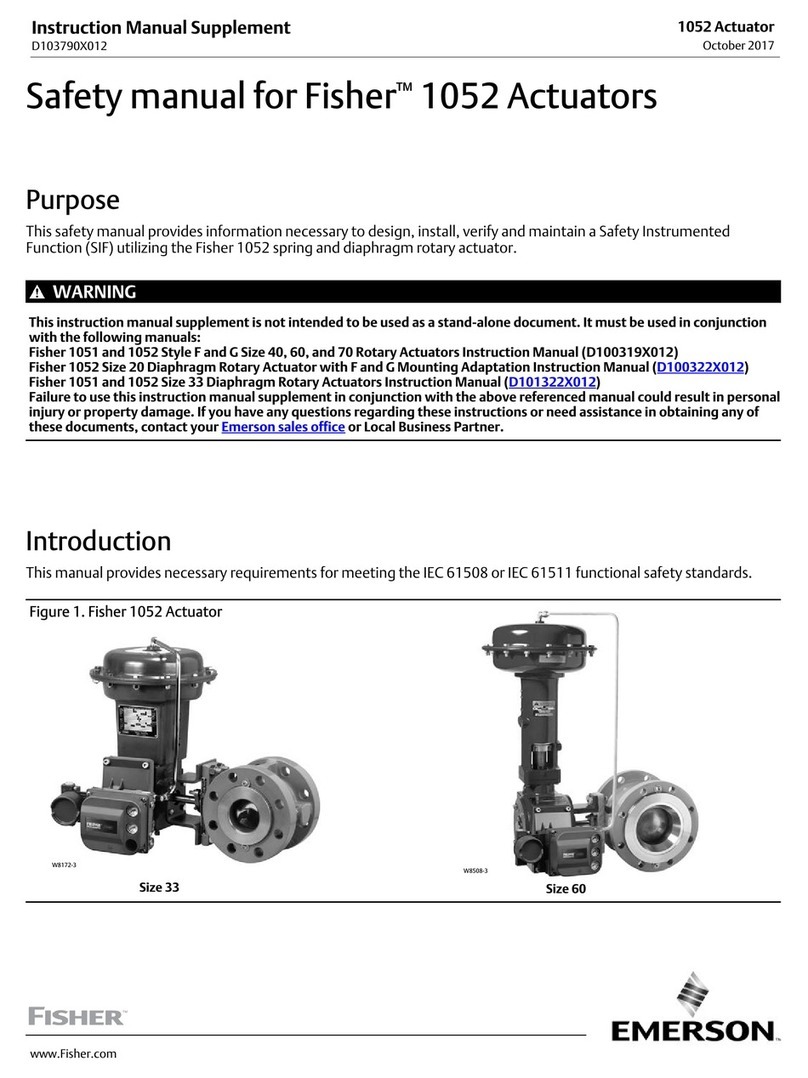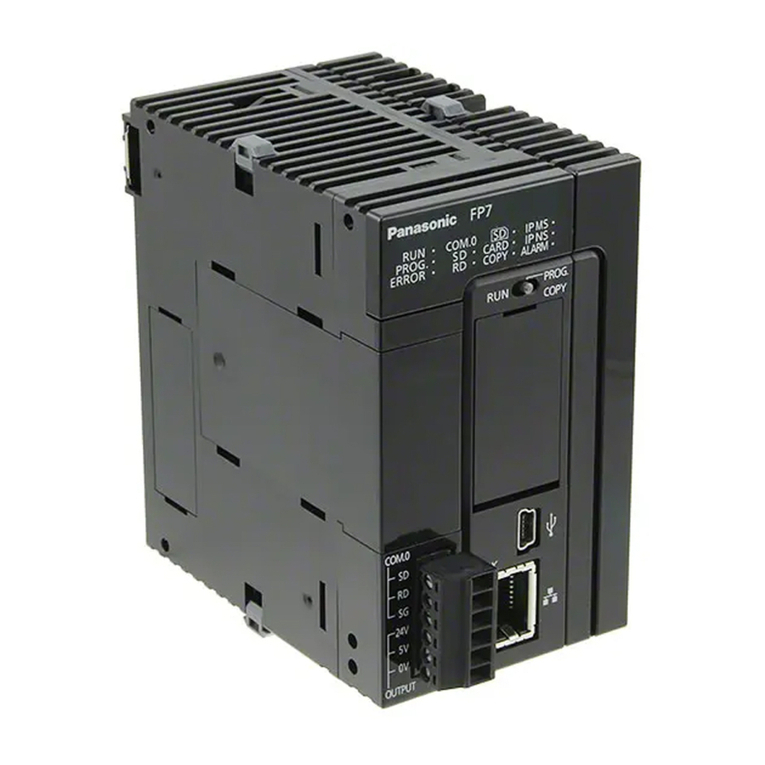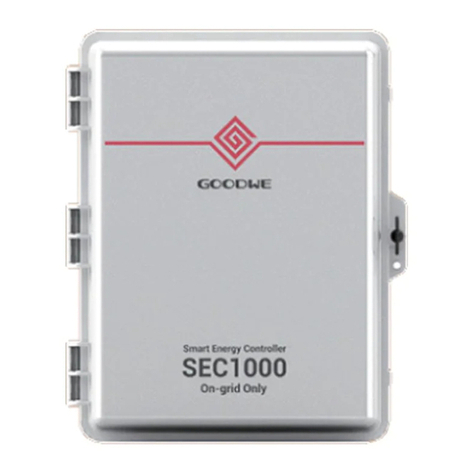Altronic DE-2500 Manual

-1-
ALTRONIC CONTROLLER SYSTEM INSTALLATION & OPERATING INSTRUCTIONS
MODEL DE-2500 FORM DE-2500 IOI 3-04
WARNING: DEVIATION FROM THESE OPERATING INSTRUCTIONS MAY LEAD TO
IMPROPER ENGINE/MACHINEOPERATIONWHICHCOULD CAUSE PERSONAL
INJURY TO OPERATORS OR OTHER NEARBY PERSONNEL.
1.0 OVERVIEW
1.1 For help locating subjects in this document, a section index is provided on page 57. A
glossary of technical terms is also provided which begins on page 52.
1.2 The Altronic DE-2500 controller system is an electronic, microprocessor-based system
designed to sense various analog and digital input points to control and monitor industrial
compressors. The system is field-programmable using a PC (personal computer) and the
supplied DE-2500 terminal program and contains a non-volatile memoryto store the setup.
Serial communications provide an interface to PC’s, PLC’s, modems and satelliteuplinks for
remote communication. A backlit 4x20 LCD character display shows system status,
programmedengine/motorandcompressorparametersandchannel labels. Afrontmounted
keypad serves as the user interface. The DE-2500 provides for both the safety shutdown
functions needed to prevent unnecessary damage to remote operated equipment and the
closed loop automatic control functions needed to optimize their efficiency of operation.
Additionally, the DE-2500 provides for remote data acquisition and supervisory control in a
compact,low costpackagededicatedtoindustrialcompressorapplications. Theoptimization
strategies available for the management of compressor throughput include automatic prime
mover speed setting as well as capacity control. On rotary screw compressors, capacity
control can be done via suction throttling, or using an internal gas bypass technique
employingpoppetvalves,turnvalvesorslidevalves. Onreciprocatingcompressors,capacity
can be controlledusing external gas bypass loops orpressure regulationtechniques.A wide
rangeof output options, including both analog current loopsand digitaloutputs, are provided
tointerfacewiththe largevarietyof actuationsystemscurrentlyin use. Inaddition, automatic
load limiting based upon prime mover power capabilities or other application specific
limitations,suchascoolingcapacity,arereadilyimplemented. ThereisalsoanAUTOSTART
option that is enabled using the terminal program.
1.3 The system consists of three main parts: a panel mounted Display Module DE-2500, a
Power Supply Module 691122-1, anda Terminal Module691127-1. These components are
interconnected by means of Cable assembly 693115-1.
WARNING: THE CONTROLLER SYSTEM MUST BE CONFIGURED PRIOR TO USE ON A
COMPRESSOR SYSTEM. REFERENCE DE-2500 PI PROGRAMMING
INSTRUCTIONS, FOR INSTRUCTIONS DESCRIBING HOW TO CONFIGURE THE
CONTROLLER FOR THE SPECIFIC APPLICATION. VERIFY THE PROGRAM IN
NONVOLATILE MEMORY (THE EEPROM) PRIOR TO STARTING THE SYSTEM.
REFER TO SECTION 10.0 ON HOW TO VIEW THE CURRENT CONFIGURATION.

-2-
2.0 DISPLAY MODULE
2.1 The DisplayModule servesas theuser interfacefor theDE-2500 system. Itis in a 6.5" x 6.5"
panel mounted enclosure and consists of an alphanumeric 20-character x 4-line backlit LCD
display, a16-keyfront-mountedkeypad,DB-25D-SubandDB-9D-Subconnectorsandthree
pairs of serial port indicators.
2.2 The keypad is a sealed membrane unit that contains the familiar STOP, RESET and TEST
keys as well as other keys used to navigate through channel status and description, view
process screens, and to edit the configuration.
2.3 TheLCD displaysa “homescreen” thatdisplaysa statusline,thespeed,thesuctionpressure
and the discharge pressure. A “view screen”, which is available by pressing the VIEW key,
displays up to eight user configurable analog process labels, values and bargraphs of the
corresponding analog inputs. Pressing the VIEW CHANNEL key displays the channel
number,itstimerstatus, analogvalue (if applicable)andthecorresponding20-characteruser
defined label.
2.4 The keypad, along with the LCD display, are used to navigate through channel status and
descriptions, view process screens, and to view or edit the system’s configuration. The
8UNITS or 9UNITS or the 6TENS or 7TENS keys areused to accesschannels by increasing
ordecreasing thechannelnumbersbyoneorbytenwitheachkey press. Pressing theNEXT
key advancesthe displayto the next screenor item. All menu adjustmentsare savedin non-
volatile EEPROM memory by pressing the ENTER key. The EEPROM memory retains the
current configuration during normal operation, after compressor shutdown and a system
power-down.
2.5 Three pairs of LED’s are provided on the back of the Display Module for troubleshooting
purposes,one Receive (RX)andone Transmit (TX) LED for each port. The TX LED will flash
when the DisplayModule is transmitting serial communications on the labeled port. The RX
LEDwillflashwhentheDisplayModuleisreceivingserialcommunicationsonthelabeledport.
3.0 POWER SUPPLY MODULE
3.1 The Power Supply Module is made to be rail mounted and is the interface between the
Terminal and Display Modules and to other systems. It typically plugs directly into the
Terminal Module using the DB-25 connectors and is held together with screws and screw
locks.
3.2 The Power Supply Module is made to accept up to four industry standard, commercially
available0.6 inch plug-in OutputModules. The Output Modules provide ameansof using the
DE-2500 controller safety shutdown system status to interface with other systems on the
engine/motor and compressor. A typical application would be as a relay or solenoid coil
driver. TheOutputModulesareopticallyisolated,solid-stateswitcheswhichareisolatedfrom
power supply minus and engine ground. The Output Modules will be in the open (de-
energized) condition when the unit is unpowered.

-3-
3.2 (continued)
Outputs1and2canbe softwareconfiguredfor either normally open(N/O) ornormallyclosed
(N/C) operation and have an LED indicator associated with them. Outputs 3 and 4 are pre-
programmed normally open for use with the optional Auto start feature. If an Output Module
is programmed for normally closed (energized for run), the LED will be ON in the normal run
condition and OFF for a fault condition. For Normally open configured modules the LED will
be OFF for normal run condition and turn ON for a fault condition.
The standard Output Modules’ outputs use the top row of the dual 16-position terminal strip
which is marked OUT 1 through OUT 4. Each of these outputs are fused with a replaceable
6.3 amp slow-blow fuse, Altronic P/N 601653. In addition to accepting industry standard
OutputModules,acustomAltronicOutputModuleP/N691124isavailablefortrippingignition
powered CD fuel valves and shorting CDignition shutdown leads upon a fault. When both
functions are required, two of these modules are used as follows: OUT 1 slot must be used
to trip the fuel valve, and OUT 2 slot must be used to short the ignition. If 12-24 Vdc is lost
to the DE-2500 annunciator system, the custom Output Modules will trip the fuel valve and
short the ignition shutdown lead. This mimics the “fail-safe” operation of a normally closed
Output Module and therefore the LED will be ON in the normal run condition and OFF for a
fault condition. In programming the system, these modules are identified by using the
IGN/FUEL selection. Terminals IGN+ and IGN!are used to connect the shutdown lead, and
FV1 and FV2 are used for the CD fuel valve. A capacitor is included in the Power Supply
Module to supply the energy to trip the fuel valve.
3.3 The 12-24 Vdc power for the DE-2500 system is applied to the power supply terminals
marked (+) and (!) 12 - 24 VDC INPUT POWER. A 6.3 amp replaceable slow-blow fuse
protects the systemfrom over currents, and apower LED lights when power is applied to the
system.
3.4 The external connection for the two serial RS-485 communication ports is on the Power
Supply Module terminal strips. Port 2 is for RS-485 serial communication to future Altronic
instruments, and port 3 is for RS-485 serial communication to a PC (personal computer) or
aPLC (programmable logic controller) to perform remote monitoring or control functions if
desired.
3.5 Terminals marked IGN IN and PU IN are usedby the DE-2500 system to detect either engine
rotation or ignition system firings. This input monitors changing signals such as those seen
oneithertheignitionshutdownleadoramagneticpickupmonitoringanenginemountedgear.
THE MAGNETIC PICKUP INPUT MUST BE USED FOR APPLICATIONS ENABLING THE
AUTO START FUNCTION.
-The IGN IN terminal connects to the positive (+) C.D. ignition shutdown lead.
- ThePU INterminal connectsto onemagnetic pickup input;theotherpickup wire connects
to the minus (!) terminal on the Power Supply Module.
NOTE: An installation may use only one of the terminals IGN IN or PU IN.

-4-
4.0 TERMINAL MODULE
4.1 TheTerminalModule ismadeto berail mounted andisthepoint ofinterfacebetweenthefield
sensorwiring andtheDE-2500 control system.A removabledualterminalstripisusedforthe
connection of the system to the equipment mounted discrete sensors which may consist of
up to 16 normally open or normally closed switches as well as 14 analog transducers. The
16 discrete sensor inputs are similar to previous Altronic DA, DD, and DE annunciator
systems and are numbered in the typical annunciatorformat as 10-17, 20-27.The 14 analog
inputs are numbered 30-37 and 40-45 and acceptindustry standard transducer signals inthe
rangeof 0-5 VDC. Connections from the Terminal Module to the Display Module are made
using the 693115-x series Cable Assembly.
44.2 The DE-2500 is designed to operate with industry standard, voltage or current amplified
output transducers in the range of 0 to 5 Vdc or 0 to 25 mA. Four series of transducers are
available from Altronic: pressure transducers 691201-x, 691204-x and temperature
transducers 691202/203-300, 691212/213-450.
4.3 PRESSURE TRANSDUCERS - The pressure transducers, Altronic P/N 691201-x and P/N
691204-x, are packaged in a rugged sealed case with a NPT pressure port, a corrosion
resistant media cavity, and aPackard Electric “Metri-Pack” connector. The ranges available
are0-100, 300,500, 1000, 2000, and 5000 PSIGfor the 691201-xseries and0-50,100, 300,
500 PSIA for the 691204-x series, all of which have an overload rating of 1.5 times full scale
withoutdamage. The three wires from the transducerare: +5 volt excitation, +0.5 to 4.5 volt
output, and minus return. These three wires connect directly to the back of the Terminal
Module using cable assembly P/N 693008-x.
4.4 DIFFERENTIAL MEASUREMENTS - On DE-2500 systems above serial number 1525 and
programmed using Terminal Software version 2.0 or above, differential pressures or
temperatures may be measured by using two consecutive channels. The transducers used
to measure differential values must be of the exact same type and range. The first channel
of the pair will display thebasic parameter it is monitoring and the second channel of the pair
will display the numeric difference in engineering units of its value subtracted from the first
channel’s value. Setpoints for each channel monitor the displayed value of that channel.
4.4 TEMPERATURE TRANSDUCER - The temperature transducers, Altronic P/N 691202-300,
691203-300 with a temperature measurement range of +5 to 300°F and the 691212-450,
691213-450 with a temperature rangeof -40 to +450°F arepackaged in a sealed, stainless
steel housing with a 5/8"-18 UNF threaded body, and a Packard Electric “Metri-Pack”
connector. During configuration the standard calibration for the 691202/203-300 sensor is
selected as "dEG1" and the standard calibration for the 691212/213-450 is selected by
choosing "dEG2". The three wires from the transducer are: +5 volt excitation, temperature
outputvoltage, andminus return. These wiresconnect directlyto the TerminalModuleusing
cable assembly P/N 693008-x.
4.5 THERMOCOUPLE INPUTS - The Terminal Modules above serial number 1525 and
programmedusingTerminalSoftwareProgramversion2.0or above can alsoacceptindustry
standard type “J” or “K” thermocouples on inputs 37 - 45. Automatic cold junction
compensation is built-in. The units can be configured to °F or °C. Both a high and low
setpoint is associated with each channel. The monitor can read type J thermocouples
between -76°F and +1382°F (-60°C and +750°C) and type K thermocouples between -76°F
and +1472°F (-60°C and +800°C).

-5-
5.0 MOUNTING
5.1 DISPLAY MODULE - Mount the Display Module inside a control panel or to a suitable flat
surfacesothatthedisplayis ata convenient viewing height. Adrilling templateandmounting
dimensions are provided. NOTE: Avoid mounting theunit with the LCD display facing direct
sunlight. The display operating temperature range is !31°F to +176°F (!35°C to +80°C).
5.2 POWERSUPPLY MODULE - Mount the Power Supply Module in the panel either on the
bottom or the side of the main panel. The PowerSupply Module is made to be rail mounted
onto commercially available 32 or 35mm DIN mounting rails. It is also made to plug directly
into the Terminal Module using the DB-25 connectors and is held together with screws and
screwlocks. Two end brackets P/N 610751should beusedto keep the modules from sliding
off the ends of the mounting rail.
As an alternative, the Power Supply Module and the Terminal Module can be mounted
separate from each other on the DINmounting rails but in the samepanel; in this case, a DB-
25 male/female cable such as P/N 693115-1 is used to electrically connect these modules.
The operating temperature range of the Power SupplyModuleis !31°F to +176°F(!35°C to
+80°C).
5.3 TERMINAL MODULE - Mount the Terminal Module in the panel either on the bottom or the
side of the main panel. The Terminal Module and Power Supply Module are made to be rail
mountedonto commerciallyavailable 32 or 35 mm DIN mounting rails. The TerminalModule
ismade toplug directlyintothe PowerSupplyModuleusing the DB-25D-Subconnectorsand
held together with screws and screw locks. Two end brackets P/N 610751 should be used
to secure the modules from sliding off the ends of the mounting rail. The Terminal Module
andthe Display Module are electricallyconnected with a DB-25male/femalecable,693115-x
series or equivalent. The operating temperature range of the Terminal Module is !31°F to
+176°F (!35°C to +80°C).
5.4 PRESSURE TRANSDUCER - Mount thepressure transducer in the panel or in a manifold or
tube off of the engine. Do not exposethe pressure transducer to temperatures above 221°F.
(105°C).
IMPORTANT: Pressure transducers will withstand overloads as high as 1.5 times rated
pressure. If the overload rating is exceeded, failure mayoccur. Pressure fluctuations occur
in most reciprocating systems; pick the transducer with a rating high enough to prevent
overload by peak pressures of pulsations. It is recommended that a pressure snubber be
usedwhichwillreduce the peakpressureappliedto thetransducer. Thelifeofthetransducer
will be extended with the use of a snubber or pulsation dampener.
5.5 TEMPERATURE TRANSDUCER - Mount the temperature transducer in a thermowell on the
engine or machine. The actual sensor is located at the bottom of the transducer body; to
ensure accuracy, the tip of the probe should be surrounded by the measured media.
IMPORTANT: Donotexceedtheabsolutemaximumratingofthetransducers,350°F(176°C)
for the 691202/203-300 or 450°F (232°C) for the 691212/213-450. Careshould be taken to
protect the wiring and connectors from contact with hot surfaces.

-6-
6.0 WIRING (SEE WIRING DIAGRAMS)
6.1 SYSTEM COMPONENT WIRING - A DB-25 male/female cable, 693115-x series or
equivalent, is used to connect the Terminal Module to the Display Module and secured with
the cable lock screws. If mounted on the same mounting rail, plug the Terminal Module
directly into the Power Supply Module using theDB-25 D-Sub connectors at theends of the
modulesandsecure them togetherwith thescrews andscrewlockscaptivetotheconnectors.
If thePower Supply Module andthe Terminal Module are mounted separate from each other
(must be mounted in the same panel) a DB-25 male/female cable such as P/N 693115-1 or
equivalent is used to connect these modules.
6.2 POWER WIRING - Connect the supply power wires to the 12-24 Vdc input power terminals
on the power supply, plus to terminal (+) and minus to terminal (!); power requirement is 12
to 24 Vdc (10 watts max.). The DC!terminal must be connected to panel groundwhich
should be the same as engine ground.
NOTE: This is the return path for normally open sensors and must be connected for proper
operation. DO NOT ground this device directly to the ignition system common coil ground.
6.3 SENSORWIRINGDISCRETEINPUTS-Thesensorleadsconnecttotheremovableterminal
strips on the Terminal Module. The terminal numbers correspond to the display numbers
whichalso have a user assigned 20character label associated with it. The sensor inputs are
numbered similar to previous Altronic DA and DD annunciator systems: 10-17, 20-27. The
set of terminals labeled R and S are for remote Reset and Stop respectively, with AUTO
START disable. WithAUTOSTART enabled, Reset is wired fora startswitch. Sensorinputs
10-27 can be user-configurable as class A, classB or classC logic. Any sensor point canbe
wired for normally open or normally closed operation.
- Normally Open (N/O) sensor switches are wired with one wire to the bottom terminal strip
ofthe respective sensor number and the other to engine ground which should be the
same as power minus (!). A short jumper from the bottom terminal to the top terminal
must be connected for normally open sensors (see wiring diagrams).
- Normallyclosed(N/C)sensorswitchesare wiredwithonewireto thebottomterminalstrip
and the other to the top terminal strip of the respective sensor number. Note that the
short jumper wire must be removed.
-Remote stop and remote reset are wired the same as the sensor switches, with AUTO
START disabled, and can beused with either normally openor normallyclosed contacts.
Usea wiresize of between16AWG(max.) to 24 AWG (min.) to connect the sensor switches
to the terminal strip connector. Strip the insulation back 3/8"; twist the exposed wires tightly
together. Insert the exposedwire completely into the terminalstrip and securely tighten the
clampingscrew. Wires runningtosensorswitchesmustbeingoodconditionor replacedwith
newwires. When running wires, take carenot todamage the insulation andtake precautions
against later damage from vibration, abrasion, or liquids in conduits. An explosion-proof
conduit is not required. However; wires should be protected from damage by running them
in a protective conduit or in sheaths where appropriate. In addition, it is essential that the
following practices be adhered to:
A. Never run sensor wires in the same conduit with ignition wiring or other high energy
wiring such as the AC line power.
B. Keep secondary wires to spark plugsand other high voltage wiring at least eight inches
(200mm) away from sensor and sensor wiring.
C. Sensor switches may be connected to any passive device using contacts such as
standard switch gauges, pressure or level switches. DO NOT connect sensor leads to
any voltage producing element.

-7-
6.3 (continued)
D. In the case of a field conversion, where sensors have previously been used with Murphy
tattletales,itisrecommendedthatthesensorsbecheckedfrequentlywhentheDEsystem
is first put into use. Sensor contacts may be burned or pitted from past exposure to
ignition system primary voltage. It is advisable to replace such sensors.
E. If it becomesnecessaryto check sensor switch to panel wiring withan ohmmeter or other
checker, first DISCONNECT the plug-in terminal strips from the Terminal Module.
Applying voltage to the DE-2500 system through the sensor leads may damage the
device. The area should be tested as non-hazardous before such testing commences.
ANALOGSENSORWIRING-Foreachanalogmonitoredpoint,inputs30-37and 40-45,select
atransducer - either an Altronic pressure or temperature transducer listed above or one that
outputs a signal in the range of 0 to 5 Vdc or 0 to 25 mA. Mount as described above. Use
cable assembly 693008-x or similar to wire transducer to the Terminal Module. An internal 5
volt sensor supply (500 mA. max.) is available to power the Altronic transducers; see wiring
diagrams. If the 5 volt sensor supply exits the panel, it must be fused with a 0.5 ampere fuse.
If 24Vdc powered sensors are used, the 24 volt supply to them must be fused appropriately.
Take care not to damage the insulation when installing and take precautions against later
damage from vibration, abrasion, or liquids in conduits. In addition, it is essential that the
following practices be adhered to:
A. Never run sensor wires in the same conduit with ignition wiring or other high energy wiring
such as AC line power.
B. Keep secondary wires to spark plugs and other high voltage wiring at least eight inches
(200mm) away from sensor and sensor wiring.
6.4 THERMOCOUPLES AND THERMOCOUPLE EXTENSION WIRE - On DE-2500 units serial
numbers1525orabove,thedirectmeasurementofthermocouplescanbeselected. Grounded
or ungrounded type J or K thermocouples may be used. Use thermocouple extension wire of
the same type as the thermocouple probe to connect to the terminal module. Use stranded
thermocouple wire having a moisture-resistant insulation such as PVC; for higher ambient
temperatures, Teflon or B-fibre insulated thermocouple wire is recommended. Toensurethat
an accurate signalis transmitted to the device, avoid any added junctions, splices and contact
with other metals. All unused inputs must be shorted with a short jumper wire between
terminals.Take care not to damage the insulation wheninstalling and take precautionsagainst
later damage from vibration, abrasion, or liquids in conduits. In addition, it is essential that the
following practices be adhered to:
A. Never run sensor wires in the same conduit with ignition wiring or other high energy wiring
such as AC line power.
B. Keep secondary wires to spark plugs and other high voltage wiring at least eight inches
(200mm) away from sensor and sensor wiring.

-8-
6.5 OUTPUTSWITCHWIRING-ThePowerSupplyModuleismadetoacceptanindustrystandard
0.6 inch Output Module. The following modules are available from Altronic:
691124 This custom module has two uses: connection to a Murphy fuel valve and directly
grounding a C.D. ignition system.
A) Use in position OUT 1 to connect to a C.D. ignition type Murphy fuel valve.
Connect terminals 3 and 8 of the fuel valve to the Power Supply Module terminals
marked F1 (FV1) and F2 (FV2).
B) Use in position OUT 2 to directly ground-out(stop)a C.D. ignition system. Wire
the C.D. ignition shutdown lead and ignition ground to the Power Supply Module
terminals marked I+ (IGN+) and I!(IGN!) observing the proper polarity for the
ignition system. DO NOT connect directly to the ignition system common coil
ground.
691125 This module israted for 5-48 Vdc,5.0 A. and may be used in anyof the four output
slots OUT 1 through OUT 4.
NOTE: Use this module if it is desired to interrupt the DC supply to DC-powered
ignition systems such as Altronic CD1, CPU-90, II-CPU or DISN.
691056 This module israted for 5-60 Vdc, 2.0 A. and may be used in anyof the four output
slots OUT 1 through OUT 4.
691066 This module is rated for 5-200 Vdc, 0.67 A. and may be used in any of the four
output slots OUT 1 through OUT 4.
691065 This module is rated for 24-280 Vac, 2.0 A. and may be used in any of the four
output slots OUT 1 through OUT 4. NOTE: Other industry standard 0.6 inch
modules may be used as required.
6.6 RS-485COMMUNICATIONS WIRING - There aretwo RS-485 communication ports available
on the DE-2500 system.
-Port 2 is for connection to an optional Altronic DSM device.
-Port 3 is for RS-485 serial communication to a PC (personal computer) or a PLC.
Use a two conductor shielded cable of fine gauge stranded wire and connect thewires for port
2to the terminals marked "A2" and "B2" and the shield wire to terminal “S2". The wiring for
port 3 connects to the terminals marked “A3", ‘B3" and “S3". Connect to the other
communicationdevices "A" to "A"(!) and "B" to"B"(+). Connect theshield wire to the DE-2500
system ONLY.
6.7 SENSEROTATIONINPUT -Terminalsmarked IGNINand PUINonthePowerSupplyModule
areused by the DE-2500 system to detect either engine rotation or ignition system firings. This
input monitors voltage signals such as those seen on either the ignition shutdown lead or a
magnetic pickup monitoring an engine mounted gear.
-The IGN IN terminal connects to the positive (+) C.D. ignition shutdown lead.
- The PU INterminal connectsto one magnetic pickup input; the otherpickup wire connects
to the minus (!) terminal on the Power Supply Module.
THE MAGNETIC PICKUP INPUT MUST BE USED FOR APPLICATIONS ENABLING THE
OPTIONAL AUTO START FUNCTION.
NOTE: An installation may use only one of the terminals IGN IN or PU IN.

-9-
7.0 HAZARDOUS AREA OPERATION
7.1 TheDE-2500 system is CSAcertified for CLASSI, DIVISION 2, GROUPS C and Dareaswhen
mounted in a suitable enclosure.
In addition, the following requirements must be met (see NFPA standard no. 493):
1. The low voltage sensor switch wires within the panel enclosure must be kept at least two
(2) inches away from other wiring. Run the sensor switch wires leaving the panel in a
separate conduit from all other wiring and keep them separate throughout the installation.
2. Wiring to the sensors must have a grade of insulation capable of withstanding an AC
voltage of 500 volts RMS.
3. Sensor wires must be run inseparate conduits and junction boxes from high voltage wires
such as ignition, fuel valve, and other high voltage wiring.
WARNING: SUBSTITUTION OF COMPONENTS MAY IMPAIR INTRINSIC SAFETY AND/OR
SUITABILITY FOR CLASS I, DIV. 2, GROUPS C and D.
DO NOT DISCONNECTEQUIPMENT INDIV. 2ENVIRONMENTUNLESS POWER IS
SWITCHED OFF OR THE AREA IS KNOWN TO BE NON-HAZARDOUS.
8.0 KEYPAD DESCRIPTION
8.1 TheDE-2500controllerDisplayModulecontainsasixteen-keysealedmembranekeypad which
is used to stop, reset and test the system. The user can also view process information
screens, view channel specifics, cancel timers, and view and edit pertinent operating
parameters.
8.2 STOP - The STOP key is used for a manual stop condition. By pressing the STOP key, the
controller activates the configured output modules in the power supply.
8.3 RESET - The RESET key clears all past faulted points and resets all input and output timers
to their preset values.
8.4 TEST - The TEST key disablesthe output modulesand allows the user tofault or test the input
sensors. Every time the test button is pressed, the test timer resets to its preset value.
8.5 CANCEL TIMERS - The CANCEL TIMERS key cancels all timers.
8.6 VIEW CHAN - The VIEW CHANNELS key allows the user to view the status of any input
channel and its user defined label.
8.7 NEXT - The NEXT key allows the user to view the CAPACITY CONTROL & RPM SETPOINT
CONTROLscreens from the home screen. From the VIEW screen, allows the user to view the
next process information screen. From the MENU screens, the next value to be edited.
8.8 VIEW - The VIEW key allows the user to view the process information screens.
8.9 ENTER - The ENTER key is used to accept a selection and to save a new value in memory.
8.10 ESC - The ESCAPE key enables the user to exit any view channels, information or menu
screens at any time and return to the previous screen without changing programmed values.

-10-
8.11 MENU - The MENU key allows the user toenter the edit menu. The global timers, input class
output assignment, output configuration and the time and date may be viewed and adjusted
using the MENU key.
8.12 UNITS/TENS -8UNITS/9UNITSkeys increaseordecreasevaluesbyone. The6TENS/7TENS
keys increase ordecreasevaluesbyten. Thesekeys areusedtoincreaseordecreasechannel
numbers, timers and to move the pointer in the menu screen.
8.13 F1 - Function key F1 displays the hourmeter and servicemeter messages.
8.14 F2 - Function key F2 displays the time and date of the first fault.
8.15 F1 and F2 keys can be used in conjunction with other keys to implement custom functions.
9.0 UNDERSTANDING THE HOME SCREENS
9.1 The "home screens" are described as a series of screens used to display several of the most
criticaloperating parameters on one screen. All of the home screens providea status word on
the upper line, and typically the engine speed on the second line, the suction pressure on the
third line and the discharge pressure on the fourth line. Other analog parameters may be
programmed in for the second, third and fourth lines.
The status line will read one of the following: TIMERS ACTIVE, RUNNING,
TEST XXX SEC, FAULT AL12, MANUAL STOP, AUTO START.
The LCD display always reverts back to one of the home screens after a keypad operation is
completed or the operation times out.
9.2 To manually start the engine, press the RESET button. The “TIMERS ACTIVE” message will
be displayed and remains until all Class B and Class C inputs have been armed. During the
time that the Class B and Class Ctimers are still active, manually purge and crank the engine.
STATUS TIMERS ACTIVE
SPEED 330 RPM
SUCTION 102.3 PSIA
DISCHARGE 200 PSIG

-11-
9.3 Ifthe AUTO STARToption is selected whenprogramming thesystem fromthe PC,the display
below willappear when the AUTO START sequence begins. The auto start sequence allows
for activation of an electrically controlled pre-lube pump for a programmed time period prior
tocranking. It is recommendedthat awarninghornor flashinglightbe activatedby the pre-lube
outputto inform anypersonnel which may be present that acranking attempt is about tobegin.
After this user programmed time delay, cranking will begin. A user programmable crank
disconnect speed switch function will automatically disable the starter at the selected RPM. If
the crank disconnect RPM is not reached within a user programmed time period an
OVERCRANKFAULTwillbegeneratedturningoffthefuelandignitionanddisablingthestarter
until a new AUTO START command is received.
STATUS AUTO START
SPEED 130 RPM
SUCTION 102.3 PSIA
DISCHARGE 200 PSIG
9.4 After all Class B and Class C points have timed out and are being monitored, and if no faults
aredetected, the homescreenwill show the“RUNNING” message. This is thescreen that will
remain under normal operation.
STATUS RUNNING
SPEED 1000 RPM
SUCTION 102.3 PSIA
DISCHARGE 300 PSIG

-12-
9.5 Whenever a programmed servicemeter interval has expired, a*character will be displayed at
the end of the STATUS word on the top line of the HOME screen. If programmed to do so,
when using Terminal version 2.0 or above, Digital control output #7 will turn “ON” when any
service meter interval has expired. This output can be used to trigger a horn or light or to
initiatea servicecall. The servicemeter will showthe hours remaining until ascheduled service
functionis required. When a service function is overdue, the hours left will display0. Press the
F1 key to display the servicemeter messages.
STATUS* RUNNING
SPEED 1000 RPM
SUCTION 102.3 PSIA
DISCHARGE 300 PSIG
F1
Press to
view
message
HOURMETER / SERVICE
MESSAGE NUMBER:00
TOTAL HOURS: 8971
OPERATING HOURS
UNITS
press to
change
number
HOURMETER / SERVICE
MESSAGE NUMBER: 01
HOURS LEFT: 100
OIL CHANGE REQUIRED
UNITS
press to
change
number
Proceed through the servicemeter messages to find the required service. The number of
hoursleftuntil thelisted maintenanceis due isdisplayed for each service message. When
the hours left reaches zero the * character is displayed on the home screen status line.
HOURMETER / SERVICE
MESSAGE NUMBER: 02
HOURS LEFT: 0
OIL CHANGE REQUIRED
UNITS
press to
change
number
F2
press to
reset
hours left

-13-
9.5 (continued)
There are up to eleven user programmable service messages. The desired messages and
service intervals are selected when programming the DE-2500 system. The service intervals
can only be changed by using the terminal program and the PC. The servicemeter alert can
be reset after the required service is performed by pressing the F2 key with the desired
message displayed. Each servicemeter message is individually reset.
9.6 FOLLOW THIS SECTION FOR DE-2500 UNITS PROGRAMMED FROM TERMINAL
VERSION 1.0 TO 1.8. FOR DE-2500UNITS PROGRAMMED FROM TERMINAL VERSION
2.0 OR ABOVE, SEE SECTION 9.7. UNITS WITH SERIAL NUMBERS BELOW 1525 CAN
ONLY USE TERMINAL VERSION 1.8 OR LOWER.
From the RUNNING home screen, the CAPACITY CONTROL home screen is accessed by
pressingthe NEXT keyonce. This homescreen willdisplay the current controllermode, AUTO
or MANUAL, and status of the capacitycontroller function, including hold position, loading and
unloading. Additionally, load inhibit or forced unload conditions caused by secondary control
inputs overriding the primary controller output are also displayed.
NEXT
press
twice
to view CAPACITY: AUTO
HOLD POSITION 95%
CHAN 31 10.0 PSIA
SUCTION PRESSURE
Indicatesthat the currentvalue of channel 31 which is the Primary controlsetpoint is within the
allowabledeadbandofthe controllerand nocontroller output changeis beingmadeatthistime.
CAPACITY: AUTO
LOADING 96%
CHAN 31 11.0 PSIA
SUCTION PRESSURE
Indicates that the current value of channel 31 is above the desired setpoint by more than the
allowable deadband and the output of the controller is being changed to increase the load,
which will cause the suction pressure to decrease towards the setpoint.
CAPACITY: AUTO
UNLOADING 94%
CHAN 31 9.0 PSIA
SUCTION PRESSURE
Indicates that the current value of channel 31 is below the desired setpoint by more than the
allowabledeadband and that the output of the controller is being changed to decreasethe load
which will eventually cause the suction pressure to increase towards the setpoint.

-14-
9.6 (continued)
By programming limits on the secondarycontrol channels, further loading of the compressor
can be inhibited until the conditions return to the desired range. Additionally, the option of
forcing an unloading of the compressor can also be selected. The control home screen will
display the override action and the channel number of the responsible input. The capacity
control home screen displays which will appear are shown below. For more detail on primary
and secondary controller options see section 22.
LOAD INHIBIT
CAPACITY: AUTO
LOAD INHIBIT-34 95%
CHAN 31 11.0 PSIA
SUCTION PRESSURE
Indicates that further loading of the compressor is being inhibited by a secondary control
function assigned to channel 34.
FORCED UNLOAD
CAPACITY: AUTO
FORCE UNLOAD-36 94%
CHAN 31 10.0 PSIA
SUCTION PRESSURE
Indicates that the compressor is being forced to unload due to a secondary control function
assigned to channel 36.
To disable the automatic capacity control and force the controller output to a particular value
press the F1 key. The displaywill indicate that the unit is in MANUAL and the current value of
the output. Use the UNITS arrow keys to change the value.
F1
press to
change
mode CAPACITY: MANUAL
HOLD POSITION 94%
CHAN 31 10.0 PSIA
SUCTION PRESSURE
UNITS
press to
change
value

-15-
9.6 (continued)
From the RUNNING home screen, the RPM SETPOINT CONTROL screen is accessed by
pressing the NEXT key twice. This home screen will display current speed control, AUTO or
MANUAL, and the status. There are three possible status messages displayed: HOLDING,
INCREASING, AND DECREASING.
NEXT
press
twice
to view SPEED: AUTO
INCREASING
CHAN 46 1830 RPM
SPEED
F1
press to
change
mode SPEED: MANUAL
HOLDING
CHAN 46 1830 RPM
SPEED
UNITS
press to
change
value
9.7 FOLLOW THIS SECTION FOR DE-2500 UNITS PROGRAMMED FROM TERMINAL
VERSION 2.0 OR ABOVE. FOR DE-2500 UNITS PROGRAMMED FROM TERMINAL
VERSION 1.8 OR BELOW, SEE SECTION 9.6. DE-2500 UNITS WITH SERIAL NUMBERS
ABOVE 1525 MAY BE PROGRAMMED USING EITHER VERSION OF TERMINAL
SOFTWARE, VERSION 1.8 OR 2.0.
Fromthehomescreen,theCONTROLLOOP#1screenisaccessedbypressingtheNEXTkey
once. CONTROL LOOP #1 is a closed loop PID controller which is assigned to the analog
valuemeasured by channel 30. This can be virtually any pressure, temperature, valve position
or other equipment parameter which can be expressed as an analog value from 0 to 5 volts.
Some typical controlled values would be the discharge pressure of a compressor, the intake
manifold pressure of an engine, the temperature of a cooling system or the chemical
composition of a process output. The first line of the display will indicate the input
channel/output channeland the current value of the controlled parameter. The next line shows
the desired value, the setpoint, of the controlled parameter. The third line shows the current
settingsof the loop tuning values; the P: 45% indicates a proportionalband setting of 45%,the
I:1s indicatesan integral term of 1 second, and the D:450m indicates a derivative value of 450
minutes.
CH30/90 42.3 PSIG
SETPOINT 42.2 PSIG
P:45% I: 1s D:450m
AUTO 58%
NEXT
press
to view

-16-
9.7 (continued)
The current values of the control loop can be viewed at any time, however, to change these
values, a specific key sequence must be entered first. To unlock the control loop values,
press the keys F2, F1, and ENTERin that order. A small arrow will appearnext to thevalue
to bechanged. Usethe arrow keysto change the value and the ENTER key toaccept the new
value. As the ENTER key is pressed, the controller will begin controlling to thatvalue and the
cursor advances to the next value. To disable the optional automatic control and force the
controlleroutput to a particular value after unlocking the control, press the F1 key. Thedisplay
will indicate that the unit is in MANUAL and the current value of the output. Use the UNITS
arrow keys to change the setpoint value.
F2
press to
unlock
values F1
followed
by ENTER
followed
by
CH30/90 42.3 PSIG
SETPOINT ÷ 42.2 PSIG
P:45% I: 1s D:450m
AUTO 58%
UNITS
press to
change
value
ENTER
to accept
new
value
CH30/90 42.3 PSIG
SETPOINT 42.2 PSIG
P:45% I: 1s D:450m
MANUAL ÷ D 58%
F1
press to
change
mode
UNITS
press to
change
value
The second control loop, CONTROL LOOP #2, is accessed by pressing the NEXT key twice
from the HOME screen. CONTROL LOOP #2 is a second independent PID loop (like LOOP
#1) andcan be programmed tocontrol based upon the analog input of Channel 31. In addition
to controlling the 4-20 mA output, based upon the channel 31 analog voltage, a closed loop
control of the input frequency being measured by the RPM input Channel 46 is also possible.
The selection of which channel acts as the control input is made when programming the unit
from the PC Terminal program. In order to change the tuning values for LOOP #2 from the
LOOP #2 screen, the same key sequence as for LOOP #1 is used.

-17-
9.7 (continued)
The screens which will appearfor LOOP #2, depending upon which program options areused,
are shown below.
or
CH31/91 42.3 PSIG
SETPOINT 42.2 PSIG
P:45% I: 1s D:450m
AUTO 58%
NEXT
press
twice
to view
CH31/91 1199 RPM
SETPOINT 1200 RPM
P: 45% I: 1s D:450m
AUTO 58%
NEXT
press
twice
to view
9.8 In addition to the two 4-20 mAanalog control loop outputs, the DE-2500offers a pulseddigital
outputcontrol option on Digital outputs #1and #2 for use withsolenoidvalves or motorvalves.
Thisoptionis referredtoasPULSECONTROLandallowsforclosedloopcontrolofthevariable
measuredby the analogvoltagemeasuredbyinputchannel 30. OnDE-2500unitsabove serial
number 1525 and programmed using terminal software 2.0, the pulse control is attached to
channel 32, allowing for three independent control loops. When PULSE CONTROL is used,
Digitaloutput #1 is used to open a valve or to increase the output when it is“ON”. Digital output
#2 is used to close a valve or decrease the output when it is turned “ON”. A decision of which
output to activate and for how long is made once per cycle. A maximum “ON” time limit is
selected when programming the unit from the PC Terminal Program. To change the control
variablesforPULSEOUTPUTS,select“EDITCONTROLVALUES”frommain menuandpress
the ENTER key. Theedit control values menu is shown. The arrow points to the “EDIT PRIM.
CONTROL”.
EDIT SETPOINTS
÷EDIT PRIM. CONTROL
EDIT PID DEADBAND
ENTER
press to
edit pulse
controls
CONTROL 35.0 PSIG
CYCLE TIME ÷ 2 s
PROP. BAND 40 %
DEAD BAND 0.5 PSIG
UNITS
press to
change
value ENTER
press to
accept or
go to next
value

-18-
9.9 On some applications, in addition to all of the standard PID control tuning, it may be desirable
to allowfor a small controller deadband in order to promote system stability. To set or edit the
PID deadband value, select this function from the Menu as shown.
EDIT SETPOINTS
EDIT PRIM. CONTROL
÷EDIT PID DEADBAND
ENTER
press to
edit PID
deadband
PID #1
DEADBAND 1.0 PSIG
PID #2
DEADBAND 0.2 PSIG
UNITS
press to
change
value ENTER
press to
accept or
go to next
value
9.10 The TEST home screen is entered by pressing the TEST key. The TEST mode disarms all
outputs and may only beentered from the RUNNING mode. The test time remaining is shown
on the top line. See section 13.0 TEST MODE SCREENS for more information.
TEST
press
to test STATUS TEST 600 SEC
SPEED 1000 RPM
SUCTION 102.3 PSIA
DISCHARGE 200 PSIG

-19-
9.11 If a fault condition occurs, the“FAULT” message for the firstfaulted channel will appear on the
displayand willremain there until it is acknowledged. The numbers onethrough two,after “AL”
(alarm), shows the output switch thatis faulted. To again view the first fault screen, press the
VIEW CHAN key. If all of the faulted sensors have been cleared and the RESET key is
pressed, the class B, C and output timers will reset and the display will return to the TIMERS
ACTIVE home screen.
STATUS FAULT AL12
1ST FAULT
CHAN 24
LOW OIL PRESSURE
ESC
returns to
fault
home
screen
STATUS FAULT AL12
SPEED 0 RPM
SUCTION 102.3 PSIA
DISCHARGE 0 PSIG
VIEW
CHAN
press to
return to
1st fault
screen
RESET
to clear faults,
reset timers &
outputs
NOTE: The reset function can also be implemented by using the external hardware.
RESET / AUTO START input availableon the TerminalModule. The behavior of the Controller and
display will be determined by the programming selections made when configuring the unit.
9.12 The “MANUAL STOP” message will supersede all of the above home screens if theSTOPkey
is pressed.
STOP
press
to stop STATUS MANUAL STOP
SPEED 0 RPM
SUCTION 102.3 PSIA
DISCHARGE 0 PSIG
NOTE: The stop function can also be implemented remotelyby using the externalSTOP input
available on the Terminal Module. The behavior of the Controller and display will be identical
to that obtained by pressing the local STOP key on the Display Module.

-20-
10.0 VIEW PROCESS INFORMATION SCREENS
10.1 Theprocess informationscreens can be accessed from anyof thehome screens(except the
testhome screen)orfromtheviewchannelscreenbypressingtheVIEWkey. There arefour
process screens: screens one and three each display up to four user programmed process
variables; screens two and four display an analog bargraph associated with the previous
process variable screen. Thus, up to eight process variables can be displayed both digitally
and in bargraph format.
The analog values are monitored by a microprocessor on the terminal board and are
configured by using a PC and the terminal program . The bargraph end points are set by the
lowand high setpoints of the safety shutdown function. Unused channel screens will not be
displayed.
STATUS RUNNING
SPEED 1000 RPM
SUCTION 102.3 PSIA
DISCHARGE 200 PSIG
from
VIEW
press
NOTE: Screens one and two display in digital and bargraph form the first group of four
selected analog inputs.
SUCTION 22 PSIA
DISCHRG 100 PSIG
FILTR 10 PSIA
BOP 110 PSIG
then at
VIEW
press to
view
bargraph
screen
SUCTION L H
DISCHRG L H
FILTR L H
BOP L H
then at
bargraph
screen VIEW
press to
view
next
screen
Table of contents
Other Altronic Controllers manuals
Popular Controllers manuals by other brands

Mitsubishi
Mitsubishi MELSEC-F Training manual
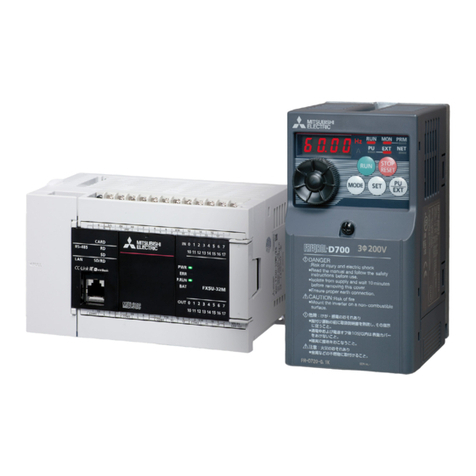
Mitsubishi Electric
Mitsubishi Electric MELSEC iQ-F Series Quick connection guide
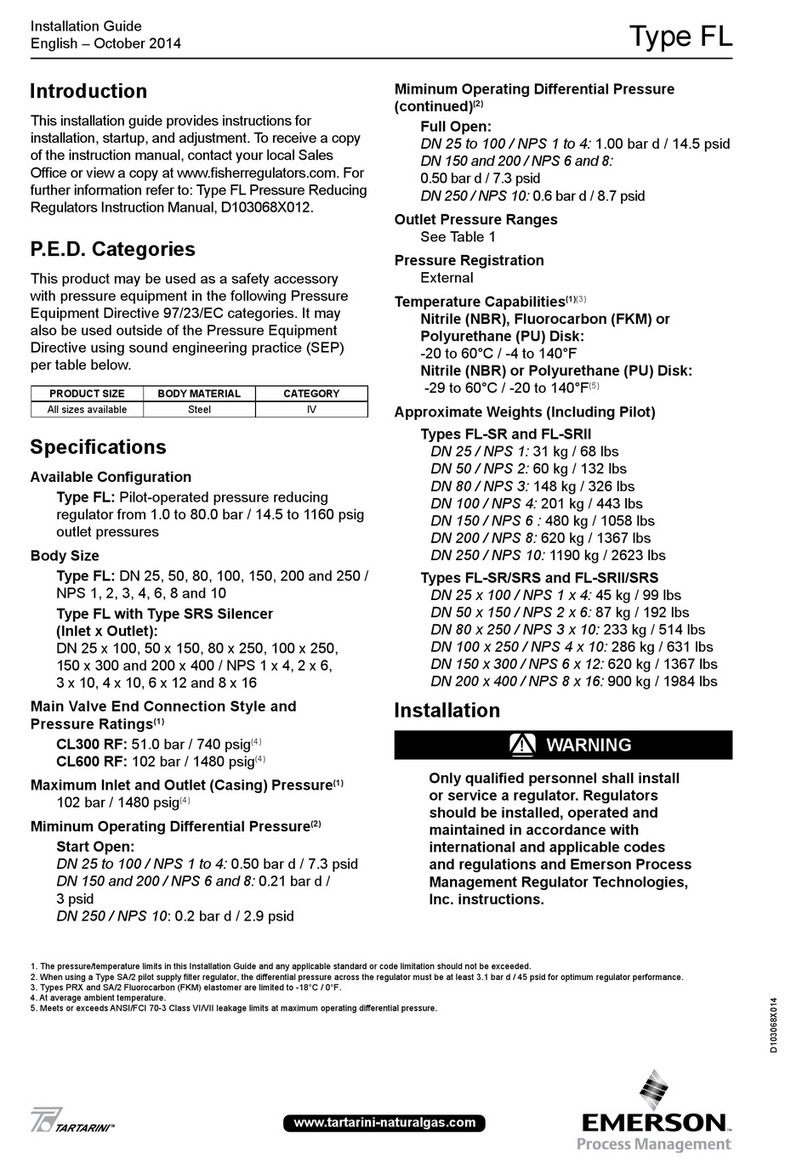
Emerson
Emerson TARTARINI FL Series installation guide
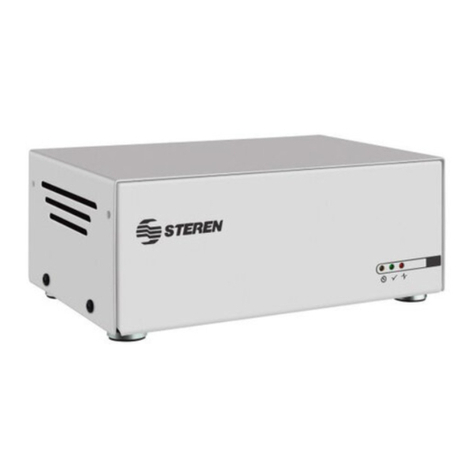
Steren
Steren 920-050 instruction manual
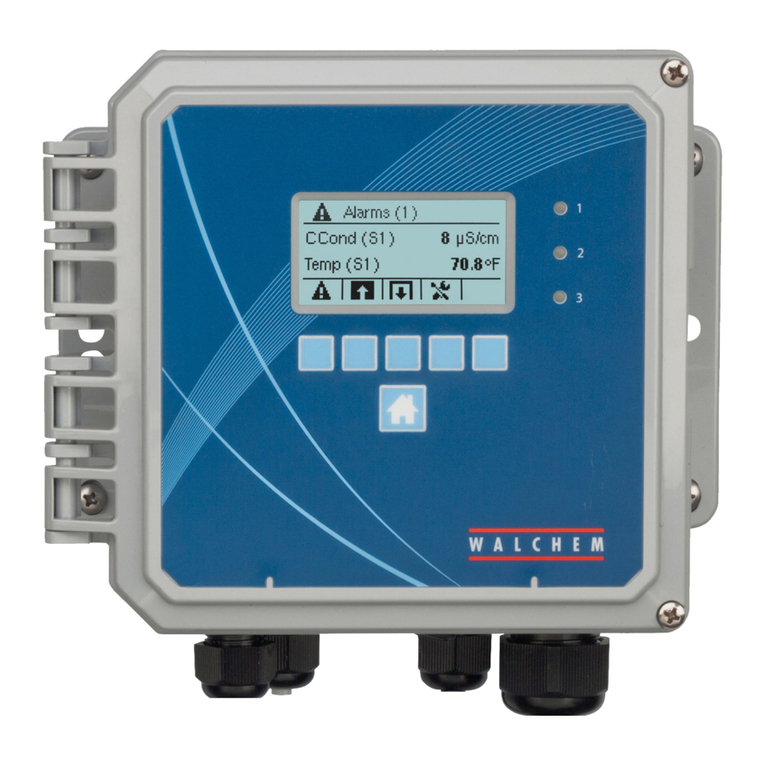
IWAKI AMERICA
IWAKI AMERICA Walchem W100W Quick programming guide
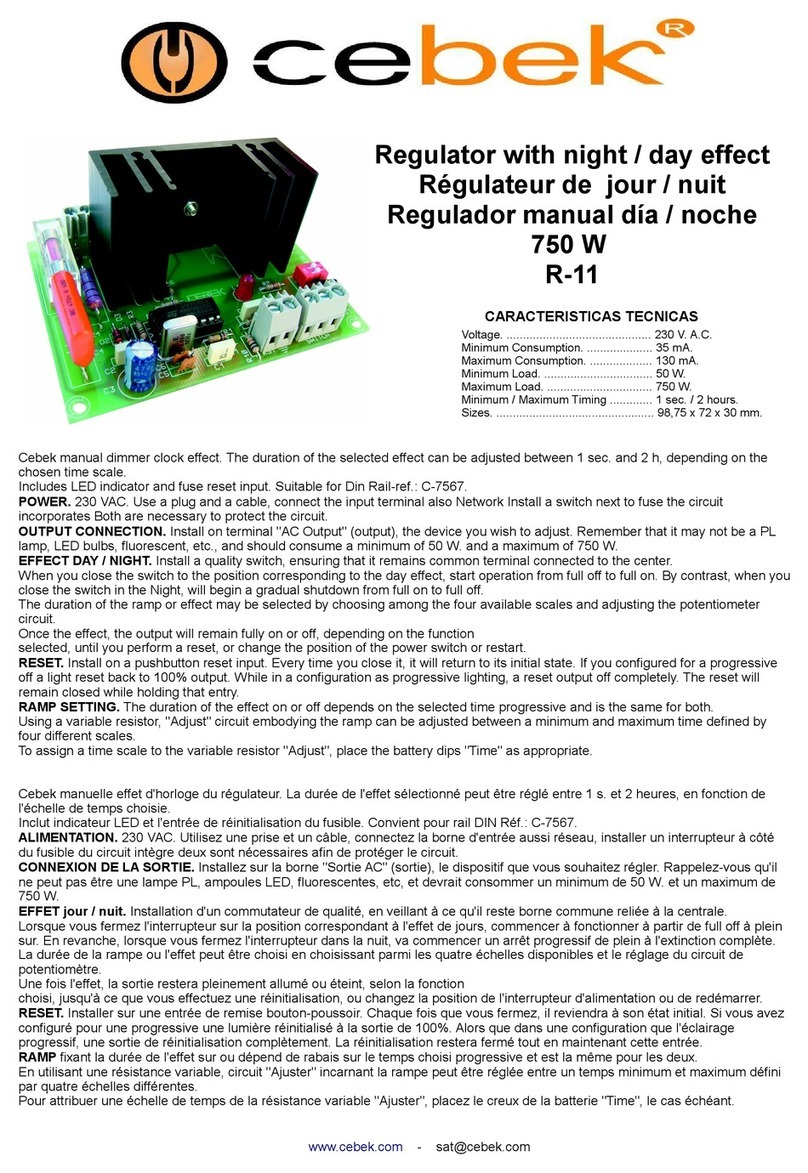
CEBEK
CEBEK R-11 manual
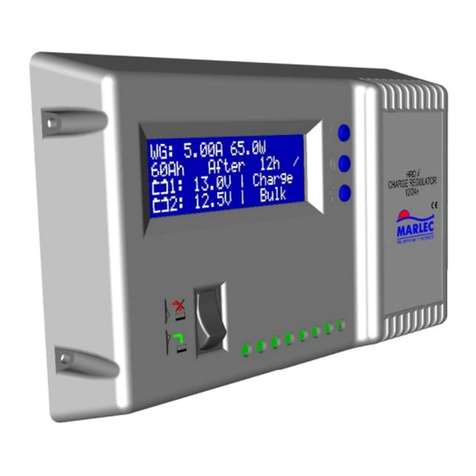
Marlec
Marlec HRDi Installation and operation
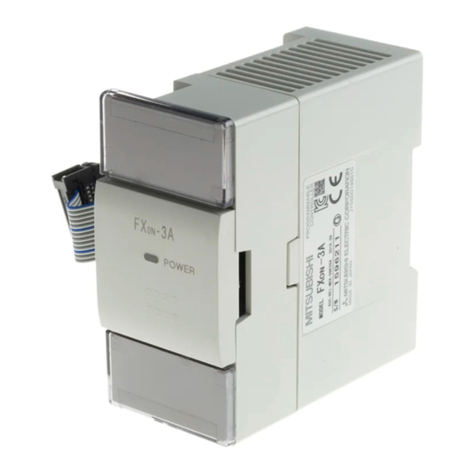
Mitsubishi Electric
Mitsubishi Electric MELSEC-F FX0N-3A user guide
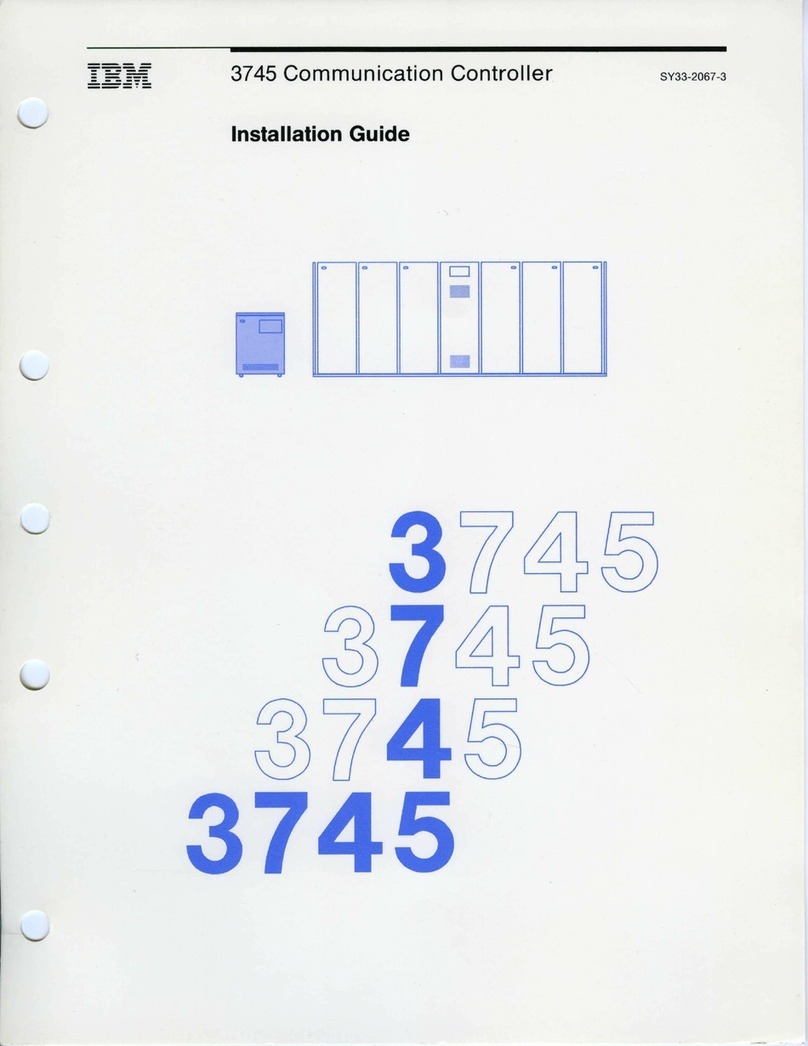
IBM
IBM 3745-130 installation guide
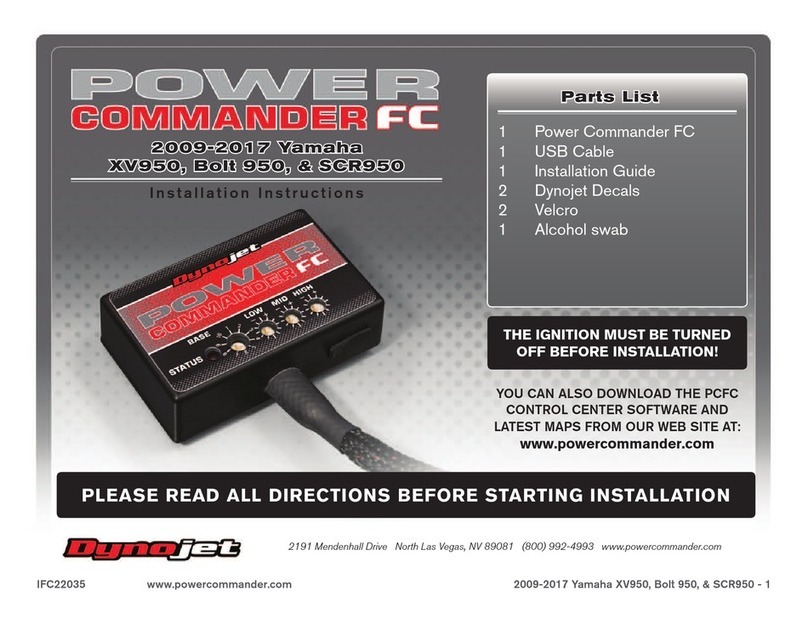
Dynojet
Dynojet Power commander FC installation instructions

Siemens
Siemens RVP550 installation instructions
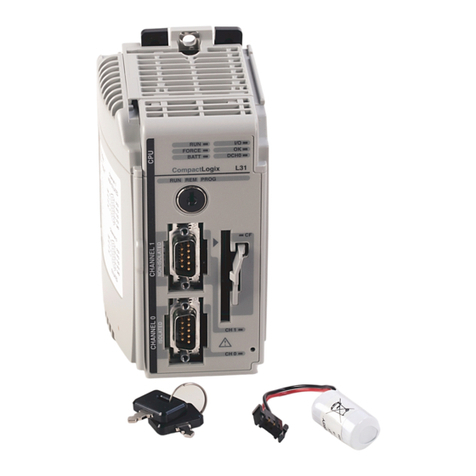
Rockwell Automation
Rockwell Automation Allen-Bradley CompactLogix 1769-L32E installation instructions
